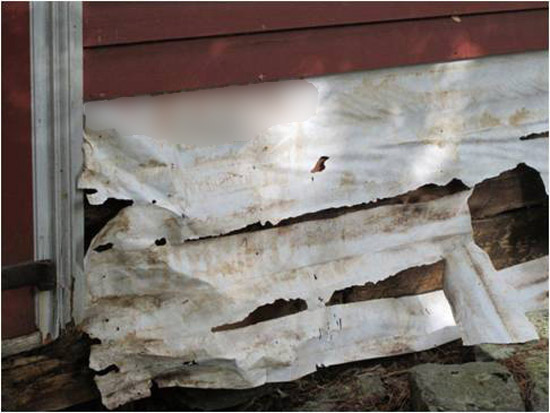Drainage and Drying in Low- and Mid-Rise External Walls
Questions to Ask
Performance testing does not always tell the whole story. In addition to understanding the published performance characteristics of a housewrap as measured by testing, design professionals should address the following questions:
 |
Housewrap that has deteriorated due to the action of surfacants. Photo provided by Benjamin Obdyke |
Does the housewrap resist surfactants?
Surfactants (surface active agents) reduce the surface tension of a liquid so it can pass through a much smaller opening and penetrate deeper into a material. In the building industry, surfactants occur naturally in materials such as cedar, redwood, stucco and stone mixes (or in mixtures used to power wash houses). Water that manages to get into a building system carries these surfactants and allows them to penetrate deeper into the walls. A housewrap can eventually lose its repellency and allow water to soak through to underlying sheathing. Some housewraps are specifically designed with coatings that resist surfactants. Drainable housewrap provides space to carry water away, thus mitigating surfactant-induced damage.
Is the housewrap drainable or non-drainable?
All housewraps are designed to “drain” since they repel water, but as with any product, that depends on the installation conditions. When siding is applied tightly against the housewrap, insufficient space is created for drainage. Therefore, some drainable housewraps utilize creping, embossing, weaving, or filament spacers to provide a gap for drainage.
Is the housewrap perforated or non-perforated?
Housewrap needs to provide holes big enough to allow vapor to pass, yet small enough to prevent liquid water from penetrating. The micro-perforated approach facilitates vapor migration, but reduces the water resistance of the final product. Non-perforated or micro-porous products allow for sufficient vapor migration while providing excellent resistance to bulk water. Most non-perforated housewraps have better water resistance than building paper even after surfactants are introduced.
Purpose of the housewrap?
Is the housewrap being used to resist water entry and reduce air infiltration? In a well-constructed wall assembly, there is little evidence that a layer of housewrap will significantly tighten a building against air infiltration. In addition, using a housewrap to provide a true exterior air barrier is difficult and complex requiring sealing and capping. In general air-sealing efforts are better spent on the building’s interior.
If the primary purpose of the housewrap is to serve as a moisture barrier, introduction of a drainage gap into the wall assembly can reduce the need for tape and cap fasteners.
Is the housewrap woven or non-woven?
While a woven fabric itself is not necessarily a concern, many woven housewraps are also micro-perforated, which compromises water resistance.
Does the cladding type matter?
It is generally understood that since reservoir claddings such as brick, stucco, and stone all pose serious concerns for water entry into a wall assembly, an air space should be included behind these claddings. But this concern does not apply only to reservoir claddings. Any siding installed tightly to a wall, including fiber cement, insulated vinyl, and wood, has the potential to hold trapped moisture. A build-up of water between the siding and housewrap can create significant hydrostatic pressures that drive moisture further into the framing materials. The type of cladding alone cannot determine whether a flat housewrap, drainable housewrap, or rainscreen would be most appropriate. Consideration of the following will help in the decision process:
Climate. The amount of annual rainfall can be used as a guide for determining the level of moisture management needed in a wall. As a rule of thumb, the Building Enclosure Moisture Management Institute recommends that “any area receiving more than 20-in. of annual rainfall should incorporate enhanced drainage techniques in the wall system, especially if using an absorptive cladding material. Areas receiving 40-in. or more of rainfall should utilize rainscreen (see Glossary) design regardless of cladding material.” With that said, only one rain event is needed to introduce water into a wall assembly. And without adequate drainage, trapped moisture can pose a risk even in dry climates.
A few years ago, an independent study, commissioned by a leading provider of building products, concluded that the biggest determinants regarding the best selection of a water resistive barrier are the amounts of rainfall and wind-driven rain to which the structure will be subjected, and the choice of siding because each type of cladding responds differently to moisture. But as indicated above, damage from trapped moisture can result after a single storm. In these times of climate change, sole reliance on rainfall data for making moisture management decisions is not advisable.
Wall assembly (tightness). In general, the more air-tight and insulated a wall assembly, the lower its drying potential. A wall with a relatively low drying potential must incorporate effective moisture management techniques. If water gets in, a wall designed to drain allows it to get out.
Exposure. Additional factors such as geographic orientation of the wall, amount of overhang, altitude, and even trees and buildings in proximity will help contribute to a more knowledgeable design decision. That information will help in understanding the potential for wind pressure, wetting, and drying, and, therefore, what level of moisture management to incorporate into a wall.









